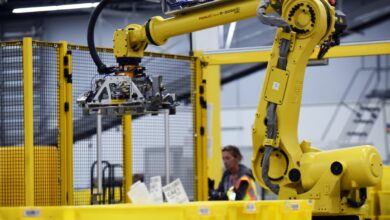NASA’s 1st lunar railway to use levitating robots with no moving parts

NASA is gearing up for the lunar economy. The US space agency is looking to build the “first lunar railway system” using robots. The Flexible Levitation on a Track (FLOAT) concept is one of many projects approved by NASA’s Innovative Advanced Concepts Program (NIAC).
If it is eventually deployed, the lunar railway system will provide “reliable, autonomous, and efficient payload transport on the Moon,” NASA explained in a statement.
The first lunar railway system
NASA’s Artemis program is facing delays due in part to delays in the development of SpaceX’s modified lunar lander Starship. When the US space agency does eventually land humans back on the Moon, though, it is expected to mark the start of a new era for space exploration.
That’s because NASA aims to establish a permanent human presence on the Moon as well as a lunar economy. This lunar base will then serve as a stepping stone for further human exploration of our solar system, starting with Mars.
“A durable, long-life robotic transport system will be critical to the daily operations of a sustainable lunar base in the 2030s, as envisioned in NASA’s Moon to Mars plan and mission concepts like the Robotic Lunar Surface Operations 2 (RLSO2),” Ethan Schaler, robotics engineer at NASA’s Jet Propulsion Laboratory (JPL) explained in NASA’s statement.
According to NASA, the FLOAT system uses unpowered magnetic robots that levitate over a 3-layer flexible film track. This includes a layer of graphite to let the robots passively float over the tracks using diamagnetic levitation. A flex-circuit layer generates electromagnetic thrust to propel the robots along the track, while an optional thin-film solar panel layer generates power.
Crucially, the FLOAT robots feature no moving parts and they levitate over the track. Essentially, all the work will be done by the track itself, while the robots themselves will essentially act as carts for transporting cargo. According to NASA, this helps to “minimize lunar dust abrasion [and] wear, unlike lunar robots with wheels, legs, or tracks”.
Building the lunar future
The FLOAT system could become key lunar infrastructure, but it won’t provide high-speed transportation. The robots will move at speeds of roughly 1 mph (1.61 km/h). They will be able to move roughly 100 tons (90 metric tons) of lunar regolith each day.
There are, of course, a lot of hurdles to overcome before the FLOAT system becomes a reality. The concept, a 2024 NIAC Phase II awardee, may compete with others, such as DARPA’s railway concept for the LunA-10 project.
NASA must firstly also establish that lunar presence on the Moon. Right now, the plan is for NASA’s Artemis III mission to send astronauts back to the lunar surface by 2026 or 2027. It will be the first crewed lunar landing since Apollo 17 in 1972.
ABOUT THE EDITOR
Chris Young Chris Young is a journalist, copywriter, blogger and tech geek at heart who’s reported on the likes of the Mobile World Congress, written for Lifehack, The Culture Trip, Flydoscope and some of the world’s biggest tech companies, including NEC and Thales, about robots, satellites and other world-changing innovations.



